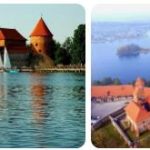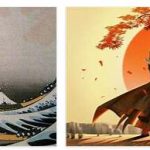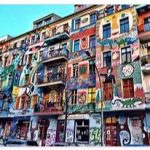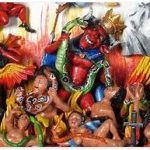Lithuanian art is, of course, in close connection with the social, political, economic and historical life of the nation. Lithuania has been called the country of historical paradoxes by some scholars. This is all the more true if we consider the apparent anomalies of his artistic development. While in Lithuania the art is manifested here and there with monuments in all similar to those observed in Western Europe, these monuments however present almost everywhere great contrasts with the wooden and thatched houses that surround them and that in their architecture simple and primitive are often admired for an unusual delicacy of lines and lightness of construction. On the one hand, the modest houses and habits of the people, its almost primitive living conditions, the singular manifestations of its rustic and popular art, on the other, the churches adorned with frescoes and stuccos, the well-furnished residences of the great lords, with rich and sumptuous architecture. But it could not be otherwise if we consider that while the people remained tenaciously attached to their culture and traditions, the lords and nobles competed in assuming the shapes of foreign art and culture.
The Lithuanian people’s attachment to tradition preserved them from denationalizing, despite the efforts that were made to this end. Only thanks to this abnormal situation could Lithuanian folk art achieve a notable development.
Prehistoric art. – Although the first manifestations of Lithuanian art proper are still hidden in the piliekalnai or ancient fortresses, in the tombs of heroes and in the ancient cemeteries, however archeology has managed to clarify some characteristics of prehistoric Lithuanian life. On the ceramics found in the excavations, decorations of double character are already encountered: the one geometric, with crosses, rhombuses, ribbons, etc .; the other is imitative, with the reproduction of plants and leaves. Technically these ornaments are obtained by means of hollows or reliefs. The same decorations were also used on amber objects, as evidenced by the objects found in the vicinity of Palanga on the Baltic Sea. Perhaps more interesting are the remains and relics from the Bronze Age which excel over those found in neighboring countries. The decoration of these objects has two ways: the first is obtained with enamel fillings in the recesses, the second is filigree with metal threads and grains interlocked to form figures of animals and plants. Those objects have a very varied shape and demonstrate a developed aesthetic sense; belong to the epoch from the century. VI to VIII called “Ragine Kultura”.
The remains and relics belonging to the so-called “Luicino Kultura” are much more modest and show little originality. They are mostly silver objects. On the other hand, the objects of the 9th century are characterized by the attempt to give the bronze the appearance of gold. Most of these objects served as an ornament to clothing. In the 11th and 12th centuries the decoration of the objects became more uniform and meticulous; then, towards the end of the century. XII, the use of adorning clothes with metallic decorations completely ceases in Lithuania.
Artistic events of the historical era. – Architecture. – At the end of the century. XII and in the sec. XIII pagan Lithuania comes into contact with the Byzantine-Russian culture, undergoing a notable influence. The most important architectural monuments of that time are the church of Saints Boris and Gleb in Koloża near Grodno (Gardinas), the Sobornaja church in Vilna and some churches in Troki (Trakai). The most interesting is the church of Koloża (12th century) which, due to the material used and the style, belongs to Byzantine architecture, but due to its architectural and pictorial decorations it belongs to a local type of which there is no equal neither in Russia nor in the Caucasus. The architect is unknown, and he showed great talent there. But although there was a period favorable to Eastern Byzantine art in Lithuania, Latin Catholicism with its features of Western culture cut off any further development. Practically a great obstacle to this development was posed by the so-called “Edict of Velune” which prohibited the construction of Orthodox churches in the town; when the application of that edict, at the beginning of the 16th century, was suspended for a certain time, any possibility of development of Byzantine art in Lithuania was now interrupted. Thus the Byzantine architecture was followed by the Gothic type which was introduced even in the Orthodox churches. Even Gothic monuments in Lithuania have many local features, so much so that their style is called “Lithuanian Gothic”. An essay, the most beautiful of its kind, is the church of Sant’Anna in Vilna built between 1392 and 1396; another is the so-called Perkunas temple in Kaunas. There are almost no monuments of civil Gothic architecture, apart from the ruins of the castle of the grand dukes in Troki. For Lithuania 2018, please check ethnicityology.com.
As in other parts of Europe, also in Lithuania the Gothic style had to give way to the Renaissance, and then to the Baroque. One of the most characteristic monuments of the Baroque is the church of the monastery of Pazaislis (near Kaunas) built between the end of the seventeenth century and the beginning of the eighteenth century by the Italian architects Lodovico Fredo and Pietro Puttini, with such magnificence that the internal walls of the temple were totally covered with rare and precious marbles transported from Italy itself.
Having regained its independence, Lithuania was forced to move its capital from Vilna to Kaunas. But this city was completely devoid of buildings suitable for the new living conditions, so that an intense construction work had to be carried out. In this period the forms of the Baroque resurrected with the introduction of special Lithuanian characters, and the architect Dubeneckis, who among other things was responsible for the restoration of the State Theater, acquired considerable fame. It is difficult to judge what developments Lithuanian architecture will take in the future, but the tendency to apply local characters and national decorative motifs is evident today.






